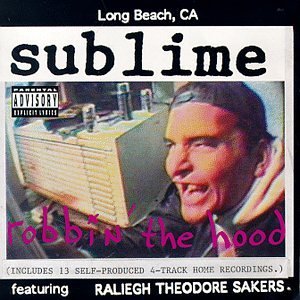Robbin’ the Hood is Sublime’s second album, released on March 1st, 1994. The album contains 24 tracks with 13 of them being self-produced, 2 being hidden, and 4 being home recordings. The main collaborators on the album include the main three, Bud Gaugh, Eric Wilson, and Bradley Nowell, with Miguel Happoldt, Kelly Vargas, and Marshall Goodman. Credit for the artwork goes to Opie Ortiz, who is on the front cover. The album was primarily recorded in various houses that Brad was staying at, but also includes songs recorded in the studio. The record strays away from the sound of their first album, 40 oz to Freedom, and has a mix of acoustic songs, random recordings, and dubs, and features tirades from a man named Raleigh Theodore Sakers.
This album really shows how creative and experimental Sublime was, and also highlights some of Brad’s main influences. It starts with a short opening instrumental song titled “Waiting for Bud”, quickly followed by “Steady B Loop Dub” and “Raleigh Soliloquy Pt. 1”, which is where we hear the schizophrenic lunatic, Raleigh Sakers, rant for over a minute long. After the disjointed break, the album segues into a few of their more popular tracks. It plays the original fast, loud, and distorted version of “Pool Shark” and then leads to “Steppin’ Razor” which is their electronic rendition of Joe Higgs’ song. Moving along, we hear “Greatest-Hits” and “Free Loop Dub/Q-Ball”, which contains a sample from Primal Scream and with BadAzz being featured on it. “Saw Red” occurs after, with an appearance from Gwen Stefani. This song sounds more like their original style, being fast-paced with a simple chord progression. Getting to the middle of the album, we hear Eric Wilson’s simple, yet powerful bass line kick off on “Work That We Do” followed by Bradley’s minimalistic lyrics. “Lincoln Highway Dub” shows, which is the precursor to “Santeria”, with a simple drum beat and Brad plays a cool guitar solo throughout.
During the second half of the album, we hear more full-length, cohesive songs. “Pool Shark” is repeated though this time it’s the acoustic version. Going through, “Cisco Kid” is played, which starts off with Raleigh talking, but then turns into a full-length song. Afterward, Sakers is heard again for the second time. This next section contains multiple acoustic songs, like “Mary” and “Boss D.J”. There is a song similar to “Cisco Kid” called “I Don’t Care Too Much For Reggae Dub” which starts with a conversation with a group and goes into a beat, turning into a song. The album ends with the third and final part of Raleigh Theodore Sakers and the hidden track of “Don’t Push” which was from the album 40 Oz to Freedom.
This album is my favorite from the rest of their work because it is unique and you get to see the band’s creativity. This album is great and I would definitely recommend this to other people only if they’ve listened to their previous albums.
























































































































